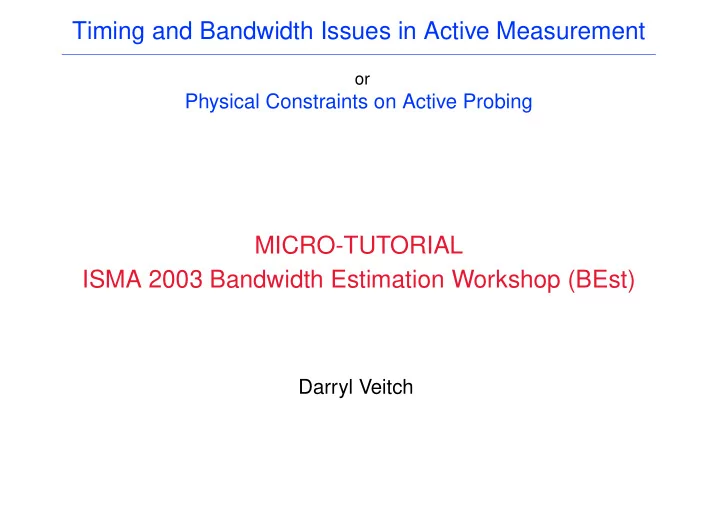

Timing and Bandwidth Issues in Active Measurement or Physical Constraints on Active Probing MICRO-TUTORIAL ISMA 2003 Bandwidth Estimation Workshop (BEst) Darryl Veitch
Essentials of Active Measurement Tap Tap ✟☎✟☎✟ ✠☎✠☎✠ Network ✄☎✄☎✄☎✄ ✆☎✆☎✆ ✟☎✟☎✟ ✠☎✠☎✠ Receiver Sender �✁�✁� ✂✁✂ ✞✁✞ ✝✁✝ �✁�✁� ✂✁✂ ✞✁✞ ✝✁✝ Sender Monitor Receiver Monitor • Probe packets are sent from sender to receiver. • Arrival and Departure times, and losses, are monitored. • Measurements used to infer network characteristics and conditions. As loss is rare, Timestamps are central. Physical layer constraints and software limitations both affect precision. 1
Factors Affecting Raw Timestamps The Probing Software [sender, sender monitor, receiver monitor] : • The software clock and its synchronisation • Location of software timestamping • Interfaces to operating system • Degree of kernel integration • System scheduling behaviour • System and event definitions The Probing Hardware [PC, clock reference, hardware monitor ] : • PC clock stability • Reference clock reliability and availability • Interrupt latencies • Location of monitor tap (if in hardware) • Kernel - NIC communication The Network [links, NIC, hubs, routers, switches] : • Architecture of switching elements (FIFO, store & forward, slow/fast path) • Hardware clock rate in switching elements • Link layer multiple paths 2
A Hierarchy of Probing Accuracy • Low end: $ Ethernet card, PC. Unix, Software clock, NTP , tcpdump , User sender/receiver. • ‘Common’ GPS solution: $ $ $ Ethernet card, PC, GPS. Unix, GPS synchronised clock, tcpdump , User sender/receiver. • Linux–TSC solution: $ Ethernet card, PC. Unix, TSC clock, driver timestamper, User sender/receiver. • RT–Linux–TSC solution: $ Ethernet card, PC. Unix, TSC clock, driver timestamper, RT sender/receiver. • A Reference solution: $ $ $ $ DAG3.2e cards, GPS, Ethernet card, PC. GPS sync’d DAG monitors, Unix, TSC clock, driver timestamper, RT sender. • High end: $ $ $ $ $ All hardware solution. 3
Obstacles to Inexpensive Accuracy ‘Features’ of the Low End: the SW–NTP–tcpdump solution • The Standard Software Clock (SW): • Based on two underlying oscillators with large skews. • getimeofday() has 1 µ s resolution and takes 1 µ s to call. • SW Synchronisation under NTP: • Offset: only bounded to ≈ 1ms under optimal conditions. • Rate: altered to control offset! up to 500PPM!! • System Noise under Unix (Linux, BSD): • Uncontrolled scheduling delays in setting, synchronising, reading, sending.. • Hardware interrupt latencies. • Timestamping and Sending • tcpdump timestamps with getimeofday() after driver. • User sender tries to schedule using getimeofday() and hopes for the best. 4
Accuracy Comparison TSC: CPU cycle register. Infrastructure Timing Accuracy Metric Offset Skew System Noise Low End 1ms – .... 5 – 500 PPM 10 µ s – 10ms Common GPS 10 µ s 5 – 50 PPM 10 µ s – 10ms Linux-TSC 0.1 – 2ms 0.1 PPM 1 µ s – 1ms RT-Linux-TSC 0.1 – 2ms 0.1 PPM 1 µ s – 10 µ s Reference 100ns 0.01 PPM < 100ns All Hardware < 100ns < 0.01 PPM < 100ns System Noise: use TSC timestamper (in driver), and RT–Linux. use TSC with accurate remote calibration. Skew: use TSC and nearby NTP primary server timestamps. Offset: 5
Limitations at High Bandwidths • Timestamps too demanding: p/µ : [40 , 1500] bytes over 1 Bbps = [0 . 32 , 12] µ s • Interrupt latencies too high, clock synchronisation insufficient • Hardware time grid: coarse in low speed switches – wipes fine details 6
Recommend
More recommend